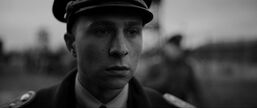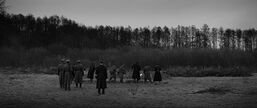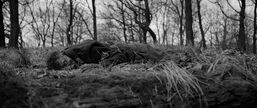Willie Herold's unit collapsed. He didn't know whether he was separated from the unit or as a deserter, he accidentally picked up a luggage with a captain's uniform on the road, and turned into a fake captain, and then recovered some stragglers along the way and started to wander around. Swagger. On the way, they came to the concentration camp in Emsland, Saxony. This place is a concentration camp specially responsible for detaining deserters like them, and they claimed that they had received a special mission from the Führer to take over the concentration camp, and then for unknown reasons. The purpose was to carry out a bloody massacre on the prisoners detained here, killing at least 195 people. After that, the concentration camp was attacked by the Allied forces. He and his accomplices fled together. Not only did they not restrain their behavior, but they intensified their actions along the way. The evil deeds continued, and finally he was identified and arrested by the German gendarmerie at the Oakley incident.
This is both the plot of the movie and the real story of Willie Herold.
In the film, Willy's more distinctive skirmishers finally abandoned the military's sense of justice in spirit and completely became the minions of the Nazi spirit.
Soldier A, the driver and guard, loyal and loyal, since the first time he met him, he really regarded him as a captain. Every time he made difficult decisions under his own conscience and the captain's orders, until he completely fell.
Soldier B, the head of the ruffian soldier, cooperated with the fake captain for interests. From the very beginning, he found out that the captain's uniform did not fit. From this, he concluded that he was a fake officer. To straighten his identity, he never recognized the captain's identity in his heart, and at the juncture of his own interests, he was not afraid to stand on the opposite side of the captain. Such as openly pointing a gun at Willie Herold when pulling a cart, ignoring his orders during a camp fight, and even robbing Willie's lover in a hotel.
Soldier C, the gangster of the ruffian soldier, as a comrade-in-arms who got along with the soldier day and night, his inner blood slowly cooled down in the missions and became insensitive. His expression in the movie explained his state of everything.
They all faced the slaughter of their compatriots from the very beginning, and they suffered in their hearts, and step by step they turned into unscrupulous robbery and innocent killing of people.
It can be seen that many people, including executioners, are unwilling to execute deserters, but under the balance of conscience and authority, they reluctantly choose to succumb to their rights. This reminds me of the trials of some war criminals after World War II. The trial could not determine whether the soldiers who gassed Jews were born murderous or simply obeyed the orders of their superiors, and whether they should be sentenced or not. To find out, Milgren was at Yale University in 1963. An experiment on obedience was initiated.
Milgren experiment
The purpose of this experiment is to test how much human nature can resist when faced with an order from an authority that goes against their conscience.
The experimental team advertised in newspapers and sent out many mailing letters to recruit participants to come to Yale University to assist in the experiment. The experimental site was chosen in a basement in the old campus of the university, which has two rooms separated by walls. The ad states that the experiment will run for about an hour and is paid $4.50 (about $20 in 2006). Participants ranged in age from 20 to 50 and included a variety of educational backgrounds, from elementary school to Ph.D.
Experimental method: The experimental subjects are divided into two opposing groups, "teacher" and "student", and their identities are determined by drawing lots, but in fact, there is only one result of the lottery, that is, the experimental subject becomes the questioner, and the other answerer is arranged in advance. actor. The "teacher" and "student" groups are in different rooms, they can't see each other, but can communicate with each other by voice through the wall.
The researchers also gave the teacher a shock controller and told him that it could shock the students next door.
The experimental process is very simple. The teacher will get a test paper and read the above questions and answers to the students one by one. After reading, the test will start. The test paper is full of multiple-choice questions. If the student answers correctly, the teacher moves on to the next question; if the student answers incorrectly, as punishment, the teacher must use the motor controller to shock the student—as the number of errors increases, the voltage also increases.
In fact, when the teacher pressed the motor controller, he would hear the screams of the students in the next room after being electrocuted. The higher the voltage, the more shrill screams. Of course, these were all pretended voices of the "pseudo-subject", but the teacher didn't know it, and thought that the students were really electrocuted to death.
When the voltage reached one hundred and thirty-five volts, there were miserable screams and scratching sounds from the next door, and many volunteers asked to suspend the experiment to check the students' conditions and began to question the purpose of the experiment. At this point, the experimenter is encouraged and ordered to keep the experiment going, while assuring the volunteers that they don't have to take any responsibility.
After getting this guarantee, all the volunteers agreed to continue the experiment and continued to increase the voltage until it reached 300 volts. Suddenly, the "pseudo-subject" next door stopped making any sound, did not answer the question, and did not make any movement. . At this time, almost every volunteer asked to stop the experiment, but the experimenter again ordered them to continue, while reassuring that they did not take any responsibility.
In this case, only 35% of the volunteers stopped the experiment firmly, and the remaining 65% finally agreed to continue the experiment until the voltage was increased to 450 volts until the experiment was completed.
This experiment has undergone many variations since then. The whole series includes 19 independent small experiments, with more than 1,000 participants, ranging in age from 20 to 50 years old, and covering various educational and professional personnel.
But no matter how the details of the experiment change, the final result is basically that nearly 2/3 of the people chose to obey and gave the highest electric shock to others.
In fact, the historical character Willie Herold's experience is basically the same as the movie, but after being released, the good times did not last long. He was arrested by the British army in Wilhelmshaven for theft. The British verified his identity and identified him as It's "The Butcher of Emsland". In August 1946, Herold and his accomplice were sentenced to death, and this time he finally paid the price for his bestiality.
In the real background before Germany's defeat, Herold acted as the authoritative role in the experiment. The deserters assembled by him were condemned in conscience at first, and then slowly and numbly obeyed his instructions. This is also a terrifying phenomenon revealed by this experiment: those ordinary people who do not have any aggression or special hostility, under the influence of certain situational forces, may completely lose their judgment in the face of the pressure of authority , becomes blind obedience, numbness and ignorance, he may touch Fan Ping's moral bottom line, go against his wishes and conscience, and make a series of unacceptable behaviors.
View more about The Captain reviews











